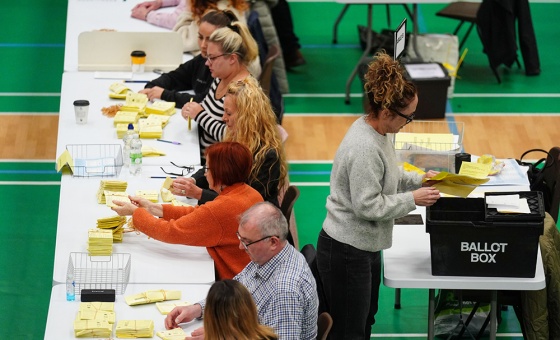This is the last article you can read this month
You can read more article this month
You can read more articles this month
Sorry your limit is up for this month
Reset on:
Please help support the Morning Star by subscribing here
I HAVE been to Orgreave on two occasions. I first went on June 18 1984. I was driven over by a friend who was doing his apprenticeship at Forgemasters. We arrived late in the morning. He dropped me off at the top of Orgreave Lane.
It was a fine, hot day. I walked down the lane with some strikers who had come down from Ayrshire Barony pit and we all anticipated that we would be involved in a Saltley Gate and shut down the coking plant at the bottom of the lane.
I headed down to the railway bridge. I stopped at the bridge on the narrow road. A mass of pickets blocked the way. I climbed up onto the bridge. Looking down towards the plant I could see the police in huge numbers behind long shields.
I watched some gaps appear in the police lines and snatch squads arresting pickets and attacking pickets. This went on for some time.
The police’s long shields then opened up and I saw police horses charging through towards the pickets followed by police carrying sort shields.
They started to advance towards the railway. I was standing on the railway bridge. Pickets started to flee in panic away from the horses and police.
Soon the narrow road was full of pickets trying to get away. I was stuck on the bridge, on one side a drop to the railway line and on the other a mass of panicked men.
To the left of me, I saw masses of men running and falling down the railway embankment. I eventually slid off the bridge just in time before the police arrived. A police horse ran full-pelt at me and other pickets.
We ran for our lives.
As I was running I felt a heavy blow on the back of my head. I fell head-first, rolled over and just missed a street sign. The sign had Rotherham Road written on it.
I was dazed but I soon pulled myself together when I saw police beating up men using truncheons and long sticks which looked like pit deputies’ sticks.
I had to get away from these coppers. They were out for blood, totally out of control, attacking men in T-shirts or no shirts, just dressed in shorts. I just thought, “Cowardly bastards.”
I jumped over a fence and hid behind some wooden pallets and caught my breath.
Other pickets were with me. I jumped on top of the pallets looking for an escape route. The road was covered in debris. There were fires and shirts, hats, belts, and clothing covering the road, total devastation.
Horses and police were prowling about. We found a hole in a fence behind an industrial unit and walked through some woods until we reached a main road. A bus was heading to Sheffield and I and some other pickets jumped on. They were from Silverwood colliery. I got the train home.
When I saw on TV what the bastard police had done that day to many decent, hard-working men who were only fighting for the right to work I had a burning anger which rages to this day. I carry what I witnessed on that day in my thoughts almost every day.
The second time I went to Orgreave was on the 35th anniversary march.
I was with the photographer John Harris who had taken the picture of Leslie Boulton, the journalist who was nearly struck by the maniac policeman on the horse with a police stick which would have probably killed her if it had made contact with her head.
He took me to the spot where he had taken the photograph. It was near a sign which said Rotherham Road. It gave me the shudders.
A lot of miners lost respect for the police during the miners’ strike. I have never had any respect for them. Growing up in Salford I and many of my friends were beaten, harassed, arrested and abused by them. We hated them. They were the enemy and the bosses’ tools, the biggest scabs of all.
What we saw on the strike was the true face of the state and the class system, violent, oppressive and brutal, maintained by these thugs in blue, the media and the so-called justice system — the whole rotten Establishment. We were ordinary working men who Thatcher called the enemy within.
The strike caused great misery for the coalfield communities and mining families.
I was just 24 years of age, the first of my three children was nine months old and my partner had little in savings, and the rent, food and bills had to be paid.
My partner Helen became very unwell with mental health issues which later in life led to her taking her own life.
Helen’s mother Jean worked for Women’s Aid and she ran the women’s refuge in Salford. I received great support from the women — food, financial help and crucially support. Jim Arnison always supplied food, chocolate and boxes of Kellogg’s cornflakes.
I used to get calls from management offering money to return to work. I always replied, “No, not until instructed by my union.”
Interestingly during the strike, the wretches at Agecroft had a year of record production, most tonnage in a year, 1984-5. The strike moved on. I did as much picketing as I could. I went to Yorkshire pits — Thurcroft, Kiveton Park and Brodsworth.
On Christmas, 1984, Terry Lewis MP organised a Christmas party for strikers’ children. Terry played Father Christmas. However, our Lancashire area leader Sid Vincent went on holiday to Tenerife. That just about said it all about some officials in Lancashire and their attitude to the dispute.
On March 3 the NUM ordered a return to work. I was gutted. I felt sick. I purposefully went back a week later. I had to see the personnel officer, a man called Davies. He was a pompous, rotund Tory. Think of Dad’s Army, a real Captain Mainwaring.
This idiot said: “You should have returned a week ago. I could have you for absenteeism.” I shouted “F*ck off!” at him so loudly that he nearly fell off his chair.
The pit manager Jennings came from his office next door and told Davies to leave, calmed the situation and told me to return the next day on the day shift. A decent man, Jennings.
Just after the return to work, a march was held in St Helens. True to form the police attacked and kettled us outside a shopping centre. So I got on with it and cracked on until July 1990, when the pit was closed.
The scabs voted for closure. I did not. Decades of coal remained to be mined. The pit had reserves of at least 60 years. It had been given a 100-year lifespan in 1960.
I was the last miner and my son would never work down the pit like his forefathers. When I left the pit I worked in homeless organisations and went to university to do a diploma in social work. I was also a full-time carer for my partner whose mental illness had made her totally dependent on my support.
I worked with George Tapp, the blacklisted electrician who was nearly killed on a picket line in 2013 by a maniac driving a car into him. George was a great supporter during the miners’ strike, a staunch trade unionist along with John Catterall, a former Morning Star reporter and a good friend of Jim Arnison.
We founded the Irwell Valley Mining Project, IVMP. Our group has built monuments at pit sites, some long closed. One of the first was on the site of Agecroft colliery. We also built a monument at the site of Clifton Hall colliery where 178 men and boys died in 1885.
We have many mining sites in the local area. We aim to mark these sites in recognition of our coalmining heritage and the women, children and men who toiled underground. We do talks to groups and we have a museum of mining memorabilia. We aim to keep history alive for future generations.
Our latest project is to place a memorial bench in the grounds of St Thomas Church in Pendleton, along with plaques with the names of the dead from Pendleton colliery which closed in 1939.
We will be unveiling the bench 40 years after the Great Strike. It’s more important than ever to remember what the children, women and men of the mining communities did in 1984-5.
We were not beaten, because we stood up and were counted. We fought against overwhelming odds and we rightly hold our heads high. We stayed loyal to our union and loyal to our class. The miners, united, were never defeated.
The Morning Star welcomes the recollections of the experiences of miners and their families during the 1984-5 strike and its aftermath. Send them to [email protected].












